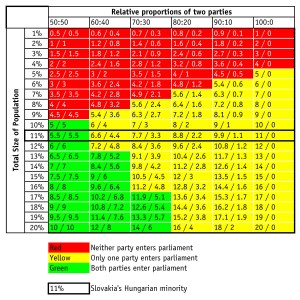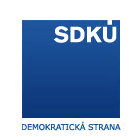![]() The last post ended with a comment on the need for understanding the nature of the conflicts and the role of political institutions, but in retrospect that is a bit premature since before I can talk about the tension between the anchoring of conflicts in socio-demographic structures and the manipulation of conflicts by political elites, I need to explore further the nature of the conflicts themselves.
The last post ended with a comment on the need for understanding the nature of the conflicts and the role of political institutions, but in retrospect that is a bit premature since before I can talk about the tension between the anchoring of conflicts in socio-demographic structures and the manipulation of conflicts by political elites, I need to explore further the nature of the conflicts themselves.
In the first post in this series, I raised a series of questions about cleavage-like conflict. The second post tried to lay out the substance of those conflicts, at least as they concern postcommunist Europe. I discussed both the socio-demographic and the attitudinal elements but stopped short of linking them because it is that linkage that is central to much of the controversy about “cleavages” and requires more attention than I had time to give. And I was not really done with the conflict question, as I had not yet dealt with the questions of dimensionality, bundling, asymmetry or … and this may have to wait for yet another day, salience. Here are the potentially problematic issues I raised in the first post:
- The degree to which positions on those issues overlap with one another, and the size of the resulting “bundle” of aligned issues
- The relative distribution of supporters and parties on particular issues or bundles (the degree to which disagreement is symmetrical and continuous or binary and asymmetrical, forming “niches”)
- The degree to which a particular issue or bundle of issues is salient for political debate
In one sense I already started to deal with the question of bundling in the previous post to the extent that, short of arguing that an particular issue is not relevant, the only way to reduce the number of dimensions of analysis is to bundle some issues with others. Of course all “issues” are themselves bundles of specific questions that touch on multiple dimensions. in some cases multiple dimensions of debate may merge (or some may submerge) to form a single dimension of competition, whereas, as Colomer and Puglese note, a seemingly-unidimensional political question can quickly become the subject of a multi-dimensional debate (2006) (The phenomenon is easily observable in the case of the U.S. health care debate in which some Republicans chose to attack the Obama admiminstration’s proposals on financial grounds while others focused on its relationship to abortion and euthanasia).
What emerges as a result is the challenge of measuring dimensionality: how many dimensions shape political competition, and what specific issues do those actually contain. As Budge and Fairlie note, the upper end of the dimensionality scale has “as many dimensions as there are political actors and public preferences held by them – forming an underlying space of almost infinite dimensions therefore”(cited in Colomer and Puglese). The need for clarity, however, calls for the least misleading possible reduction to a relatively small number. At the far end of this process of reduction, is the uni-dimensional conflict between two dominant positions which bundle together everything else (the number of dimensions more or less inversely related to the size of their bundles).
The most common framework for understanding unidimensionality, of course, is “left” and “right.” According to Mair (2007: 208) this framework still ”
appears to offer both sense and shape to an otherwise complex political reality’ at three levels. First, in terms of voters, data from the European Social Surveys conducted in recent years show that more than 80 per cent of voters define themselves as left- or right-wingers. Second, regarding observers and researchers ‘expert surveys’ systematically identify the left-right conflict as one of the most relevant issues in the competition among political parties. Third, with party programmes and electoral platforms, content analysis systematically shows that ‘some form of left-right dimension dominates competition at the level of the parties’ (Mair 2007: 209–210).
But in this dimensional reduction there emerge two significant follow-up questions: what do “left” and “right” actually mean in any particular case? and how much does the left-right dimension capture political competition in any particular country.
As Budge et al note, the positions bundled by “left” and “right” are highly idiosyncratic, differing from country to country and even from one time period to the next in a single country:
“The specific policy position contents of ‘left’ and ‘right’ or of ‘progressive’, ‘liberal’ and ‘conservative’ global ideological positions are accidental.” ‘There is after all no logical or inherent reason why support for peace (for instance) should be associated with government interventionism (also for instance).’ (Budge et al 2001, 13)
The difficulty of finding a unified sense of “left” and “right” is especially difficult in postcommunist Europe where Communist-successor parties pursue pro-market economic reforms (Tavits2009) and where debates over ethnic rights and corruption defy easy categorization into “left” and “right.” Nor do all “lefts” and “rights” easily coincide.
Recent research by Bakker et al (The Dimensionality of Party Politics in Europe, http://www.jhubc.it/ecpr-porto/virtualpaperroom/104.pdf) uses the University of North Carolina expert surveys to assess the correlations between party positions on an economic “left”-“right” scale as well as the Green-Alternative-Libertarian (GAL) versus (Traditional-Authoritarian-Nationalist) scale in which the former receives the label “left” while the latter is considered “right.” They find an average correlation coefficient between the two scales 0.65 and a correlation coefficient above 0.50 in eighteen of the twenty-four European cases they study (EU members except for Cyprus, Malta and Luxembourg) and above 0.75 in nine of the twenty-four, suggesting that a left-right dimension is fairly reliable in many cases. On this measure postcommunist countries actually scored slightly higher than other EU members. A separate analysis of unbundled issues for the same set of countries found multiple dimensions in every country, but most of the twenty-four cases, the strength of the second dimension was well below that of the first, and the ranking of dimensionality in the countries corresponded relatively well to their rankings in the analysis of the hypothesized main dimensions.
Other aspects of their work, however, suggest a degree of caution about a simple left-right framework, particularly in post-communist Europe. First, whereas all non-postcommunist cases yielded a positive correlation coefficient between economic left and “GAL Left,” among the postcommunist cases there was considerable variation: three countries showed a positive correlation (Slovenia, Latvia, Estonia) while seven others produced a negative correlation in which “economic left” coincided with “TAN Right” (Hungary, Romania, Poland, Bulgaria, the Czech Republic, and Lithuania) and one case produced no correlation at all (Slovakia) (2010, 6). Only in the first three cases, then, would it be possible to talk about a unidimensional left-right axis, while in the larger group of seven the unidimensionality is difficult to label (is a particular side to be called “left” after its economic aspects or right after its cultural aspects) and in final case the problem does not emerge because there is no dominant dimension.
The analysis also corresponds with the findings of Henjak (West European Politics 2010) and Whitefield and Rohrschneider (and before them, Lijphart, 1999), that while nearly all countries exhibit a fairly significant socio-economic dimension, there is considerable variation in the nature of the secondary and tertiary dimensions. At the risk of going further afield, I will talk about those “other” dimensions in the next post (as promised, actually) before moving on to the question of salience and from there to the conflict-related interaction between voters, party organizations and party positions.












